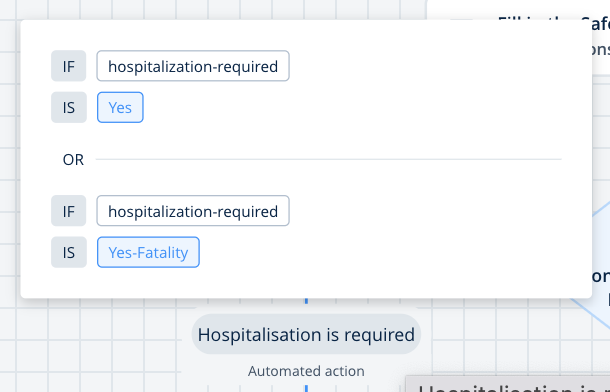Conditional Logic to automate routing in a business process
What is conditional logic?
Conditional logic functionality allows you to automate decision-making throughout the business process – based on the values entered in form fields by the field workers.
Example use cases
Conditional logic in Fluix routes completed forms to different emails, cloud storage and a CRM, or returns a task for another round of approval, and many other scenarios. Below we collected a couple examples for your convenience.
- Checklists
Instead of a manual check of content in checklists, conditional logic does an automated check based on predefined rules. Assuming a checklist has 10 checkpoints, and if all 10 are set to be OK or the values are within a predefined range, the checklist will automatically be approved and saved on cloud storage, so no human interaction is required. In case there is one check set to Not OK – the checklist will go for a review.
- Field inspections
A similar case is when a fillable form contains a field Checked with dropdown options Passed and Failed. If-then logic says: if Failed is chosen, then an email is sent to the responsible person. - Safety accident reports
An employee is injured on the job. The manager needs to submit an injury report to the office. If the supervisor chooses Yes next to Hospitalization required, conditional logic automatically routes the report to a safety director. - Employee COVID screening
Before entering a workspace, all employees fill out a Covid-screening form. If a worker checks the Fever box, they need to either WFH, due to the symptoms and include their submitted report.
- Employee hiring & onboarding
While hiring and onboarding a new person, there is a list of steps and procedures each company sets up to make the employee onboarding as smooth as possible. An employee new-hire checklist or an employee onboarding checklist would be among those forms that help both a newcomer and their manager to ensure all aspects are covered. For example in case the Info Security Agreement is not signed, the respective task is automatically assigned to the Info Security Director.
How to set up conditional logic in the business process?
Let’s look at the real-life safety injury reporting case as an example of utilizing conditional logic in Fluixthe Taskstreams. An employee is injured on the job. The Supervisor needs to submit an injury report to the Safety Director.
Step 1 – Create the first task and a form. Navigate to the Fluix admin portal, create a new Taskstream, and configure the first task for Supervisors who will fill out a safety incident report.
Step 2 – Configure the Conditional logic. Drag and drop the Conditional Logic element to the Taskstream chart and connect it with the Supervisors’ task using an arrow. By default, the Conditional logic element has two conditions: Condition 1 and Else. You may rename them as needed for more clarity. You can also add more conditions if needed (check the details in Step 3 below).
Click on the condition and configure it. In our example the report will go down this branch of the Taskstream only in case the site Supervisor enters Yes or Yes – Fatality into the hospitalization required field.
To select the field in a form, click on the configuration icon to open a dynamic values configurator.

Here is how the preview of the configured condition looks like:
Besides IS the list includes other options:

Step 3 – Decide on actions when the condition is met and not met.
In this example, when the condition is met – we chose two submit actions and connected them with the parallel action element. This way, the report will be sent by email to the Safety Director and uploaded to the required folder on cloud storage.
When the condition is not met, the form will go down the second branch of the conditional logic – in our scenario, the report will be uploaded to another folder on the cloud storage for record purposes.
In fact, you may add as many conditions as needed. Drag and drop a task or submit action and connect it with the Conditional Logic element by stretching an arrow from the latter.
Step 4 – Save changes and proceed to testing. To try the setup, add yourself to the Group of Supervisors in the Taskstream, open the app either on an iOS or Android device, or a web-based User app, and complete the task.
In fact, you may add as many conditions as needed. Drag and drop a task or submit action and connect it with the Conditional Logic element by stretching an arrow from the latter.
Step 4 – Save changes and proceed to testing. To try the setup, add yourself to the Group of Supervisors in the Taskstream, open the app either on an iOS or Android device, or a web-based User app, and complete the task.
Benefits of conditional logic
- Saved time: Conditional logic in a business process cuts off unnecessary steps of the workflow like several rounds of manual review and approval, thus allowing the team to deliver their work faster and reducing the administration effort.
- Streamlined processes: Your users only see tasks and forms that are required for their project. The system navigates them to the further workflow steps based on their inputs in forms.
- Automated notifications: With the assistance of conditional logic, your users will get only relevant notifications based on the data they enter.
- Reduced error: You as an admin get full control of the route the completed form and task is going to take down the workflow, which eliminates human error.
Conditional logic is a powerful tool to streamline your documents, tasks, and workflows. Creating automated branching based on conditional inputs can help you bring the expected logic to a business process of any complexity.
Feel free to contact us at support@fluix.io if you have any questions on setup.
